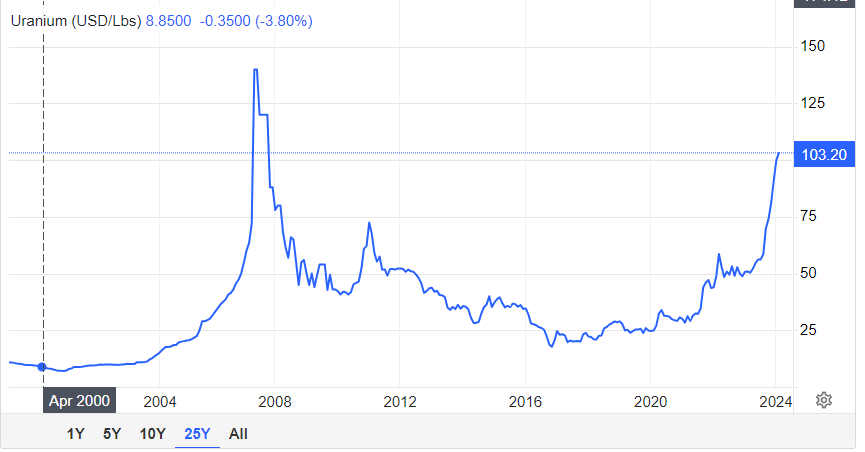Pinned straw:
Hi @TimEge, and welcome aboard!
I agree that uranium is an interesting area. Done right, I think nuclear has a lot to offer in the transition away from fossil fuels. And the case for structural supply shortage is often a compelling one (..as it was for lithium).
But in general, it's not an area I fish in:
- Market pricing for your goods is notoriously volatile and hard to predict.
- Uranium is a politically spicy arena
- Very capital intensive business. Their share count has grown substantially over the years.
- A sharp rise in the commodity price usually spurs a strong supply response (existing mines ramp up, previously uneconomic mines return to operation, and a new exploration and development cycle is kicked off)

- The LHM operation is in Africa (Namibia). There's a long history of misadventure by ASX miners in this politically dynamic part of the world.
Paladin reckons it has $445 million pounds of Uranium across it's tenements. The current price is US$100/Lbs. So assuming they can teleport all that resource to end customers, at today's prices, the asset base is worth ~$45 billion.
Of course, it's expensive to get this stuff out of the ground and then process and transport it. What kind of margins can we assume, on average, over the life of these mines? I haven't done the work, but will thumb a suck a (very generous) 20% net margin to get $9 billion in current asset lifetime value. (I'd guess free cash flow margins are waaaay lower).
And you have to discount a lot of that as it will take a decade or longer to extract it all. And of course, a sizeable amount of profit is always reinvested into exploration and new development, which means it doesn't end up in shareholder pockets. So when I look at all that (admittedly extremely rough analysis), do I think the current enterprise value of almost $4 billion represent value? Especially if the average price of Uranium ends up returning to it's longer term average.
Looked at another way, once in full production, I could see Paladin doing A$500m pa in revenue. Again assuming a generous 20% net margin, that'd be $100m in profit. At a PE of 25, that's a market cap of $2.5 billion. The current market cap is $3.8b.
I'm basing all of this on a very quick flip through of their material, so I am definitely missing a lot of context. Maybe they do a peak revenue of $1 billion, a 25% net margin, and trade at a PE of 35?? Using those assumptions, and putting that run-rate 5-years out, gives you a 15% compound annual return from today's price. So maybe shares are good value -- but you'd want to see a lot of things go right.
Others will do a much better job of determining a value, but the way I'd approach it is to answer the questions of: How much production, at what price, and what margins, by what date.
Too often these stocks fly high for a time on the supply shortage narrative, but the tough reality of mining a politically sensitive commodity in Africa and requiring significant and ongoing capital investment often ends up making initial expectations look generous. And here we've already seen a ~100% rise in the share price over the last year -- so you might be able to argue that a lot of the potential is already priced in.
Anyway, not trying to be a wet blanket, but in the Strawman spirit of offering a counterview I hope it helps.



